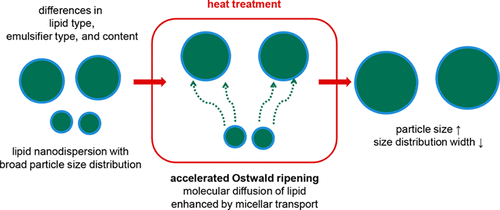当前位置:
X-MOL 学术
›
Mol. Pharmaceutics
›
论文详情
Our official English website, www.x-mol.net, welcomes your
feedback! (Note: you will need to create a separate account there.)
Heat Treatment of Poloxamer-Stabilized Triglyceride Nanodispersions: Effects and Underlying Mechanism
Molecular Pharmaceutics ( IF 4.5 ) Pub Date : 2018-07-10 00:00:00 , DOI: 10.1021/acs.molpharmaceut.8b00202 Katrin Göke 1, 2 , Elin Roese 1 , Heike Bunjes 1, 2
Molecular Pharmaceutics ( IF 4.5 ) Pub Date : 2018-07-10 00:00:00 , DOI: 10.1021/acs.molpharmaceut.8b00202 Katrin Göke 1, 2 , Elin Roese 1 , Heike Bunjes 1, 2
Affiliation

|
Lipid nanoemulsions are being investigated for the parenteral administration of poorly soluble drugs. A narrow particle size distribution in these formulations is a prerequisite for meaningful research and safe administration to patients. Autoclaving a poloxamer-stabilized trimyristin nanoemulsion resulted in moderate particle growth and a strong decrease in particle size distribution width (Göke, K.; Roese, E.; Arnold, A.; Kuntsche, J.; Bunjes, H. Mol. Pharmaceutics 2016, 13, 3187.). In this work, the critical parameters for such a change upon autoclaving poloxamer 188-stabilized lipid nanodispersions were investigated to elucidate the underlying mechanism. Nanodispersions of triglycerides with esterified fatty acid chain lengths from C8 to C18 were treated at different temperatures and for varying durations. The influence of a decrease in poloxamer 188’s cloud point was tested by adding potassium chloride to the dispersions prior to autoclaving. The influence of poloxamer 188 concentration and of the type of emulsifier was investigated. The change in particle size and particle size distribution width upon heat treatment was analyzed by dynamic or static light scattering or differential scanning calorimetry. A short esterified fatty acid chain length of the triglycerides, high temperatures, and the addition of potassium chloride were key factors for particle growth up to emulsion break up, whereas the cloud point of poloxamer 188 was irrelevant. Sodium dodecyl sulfate and sucrose laurate had negative effects on emulsion stability during autoclaving. It was concluded that the increase in particle size and the decrease in particle size distribution widths upon heat treatment resulted from heat-accelerated Ostwald ripening and not from a coalescence-based process.
中文翻译:

泊洛沙姆稳定的甘油三酸酯纳米分散体的热处理:作用和潜在机理
脂质纳米乳剂正在研究用于难溶性药物的肠胃外给药。这些制剂中窄的粒径分布是有意义的研究和对患者安全给药的先决条件。高压灭菌泊洛沙姆稳定的曲美瑞汀纳米乳剂可导致中等程度的颗粒生长并大大降低粒径分布宽度(戈克(Köke);Roese,E .;阿诺德(Arnold);Kuntsche,J。布涅斯,H。 大声笑 药剂 2016, 13,3187.)。在这项工作中,对高压灭菌泊洛沙姆188稳定的脂质纳米分散体进行此类改变的关键参数进行了研究,以阐明其潜在机理。酯化脂肪酸链长为C8至C18的甘油三酸酯的纳米分散液在不同的温度和不同的持续时间下进行处理。通过在高压灭菌之前将氯化钾添加到分散体中来测试泊洛沙姆188浊点降低的影响。研究了泊洛沙姆188浓度和乳化剂类型的影响。通过动态或静态光散射或差示扫描量热法分析热处理后的粒度和粒度分布宽度的变化。甘油三酸酯的酯化脂肪酸链长度短,温度高,氯化钾的添加是颗粒增长直至乳液破裂的关键因素,而泊洛沙姆188的浊点无关。十二烷基硫酸钠和月桂酸蔗糖对高压灭菌过程中的乳液稳定性有负面影响。可以得出结论,热处理时粒度的增加和粒度分布宽度的减小是由于热促进的奥斯特瓦尔德熟化而不是基于聚结的过程引起的。
更新日期:2018-07-10
中文翻译:

泊洛沙姆稳定的甘油三酸酯纳米分散体的热处理:作用和潜在机理
脂质纳米乳剂正在研究用于难溶性药物的肠胃外给药。这些制剂中窄的粒径分布是有意义的研究和对患者安全给药的先决条件。高压灭菌泊洛沙姆稳定的曲美瑞汀纳米乳剂可导致中等程度的颗粒生长并大大降低粒径分布宽度(











































 京公网安备 11010802027423号
京公网安备 11010802027423号